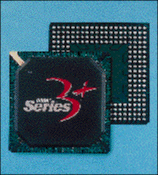1998 Product of the Year Award Winner
FPGA integrates hard cells
for common functions
The ORCA 3TP12 is the first FPGA to be made with a common fixed function
as a fully diffused cell, a practice that should become common as feature
sizes shrink. Its choice of a PCIbus interface for the first chip was in
response to demand from the communications-switch market.

The ORCA 3+ combines ASIC cells with FPGAs,
making it a harbinger of expanded functionality
in programmable devices.
The part inaugurated the ORCA 3+ family, which the company calls field-programmable
system chips (FPSCs). Other family members will include cells from the
company's own libraries.
The 3TP12 combines a Series 3 FPGA with a 32/64-bit PCI interface core.
The core complies with version 2.1 of the PCI specification and meets 66-MHz
PCI requirements in the three fastest speed grades. The PCI cell includes
a pair of 32 x 64-bit FIFOs for the master I/O function and a pair of 16
x 64-bit FIFOs for the target.
Both master and target can pass up to 528 Mbytes/s in full-burst mode.
The cell can be configured with two 32-bit buses (one in each direction)
or with four independent 16-bit buses.
The ORCA portion of the chip features 252 programmable function units
in a 14 x 18 array with 2,636 registers, 32 Kbits max of user RAM, and
187 user I/Os. The die is the same size as the 18 x 18 3T55 FPGA, with
the standard cell and its I/O displacing the four bottom rows.
Other planned FPSCs will feature Fast Ethernet, ATM, SONET, and T1/E1
network interfaces. The company also plans USB and IEEE 1394 computer interfaces,
embedded memory, DSP chips with program-mable filters, microprocessors,
and mixed-signal cells.
Design software from Synopsys, Synplicity, and Exemplar Logic currently
supports the 3+ family. The 3TP12 is packaged in a 240-pin power shrink
QFP. (3TP12-5, $79.80 ea/25,000–samples available now.)
Lucent Technologies
Berkeley Heights, NJ
Customer Response Center 800-372-2447
Fax 610-712-4106
http://www.lucent.com/orca
Advertisement





